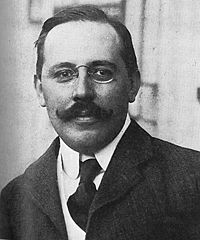Josef Hoffmann
| Josef Hoffmann | |
 |
|
| Personal information | |
|---|---|
| Name | Josef Hoffmann |
| Nationality | Austrian |
| Birth date | December 15, 1870 |
| Birth place | Brtnice,Moravia, Austria-Hungary |
| Date of death | May 7, 1956 (aged 85) |
| Place of death | Vienna, Austria |
| Work | |
| Significant buildings | Stoclet Palace Villa Primavesi Sanatorium Purkersdorf |
-
- For the Polish-American pianist, see Józef Hofmann.
Josef Hoffmann (December 15, 1870 Brtnice, Moravia – May 7, 1956 Vienna, Austria) was an Austrian architect and designer of consumer goods.
Contents |
Biography
Hoffmann studied at the Higher State Crafts School in Brno beginning in 1887 and then worked with the local military planning authority in Würzburg. Thereafter he studied at the Academy of Fine Arts Vienna with Karl Freiherr von Hasenauer and Otto Wagner, graduating with a Prix de Rome in 1895. In Wagner's office, he met Joseph Maria Olbrich, and together they founded the Vienna Secession in 1897 along with artists Gustav Klimt, and Koloman Moser.[1] Beginning in 1899, he taught at the University of Applied Arts Vienna. With the Secession, Hoffmann developed strong connections with other artists. He designed installation spaces for Secession exhibitions and a house for Moser which was built from 1901-1903. However, he soon left the Secession in 1905 along with other stylist artists due to conflicts with realist naturalists over differences in artistic vision and disagreement over the premise of Gesamtkunstwerk.[2] With the banker Fritz Wärndorfer and the artist Koloman Moser he established the Wiener Werkstätte, which was to last until 1932. He designed many products for the Wiener Werkstätte of which designer chairs, a lamp, and sets of glasses have reached the collection of the Museum of Modern Art,[3] and a tea service has reached the Metropolitan Museum of Art.[4]
Hoffmann's style eventually became more sober and abstract and it was limited increasingly to functional structures and domestic products. In 1906, Hoffmann built his first great work, the Sanatorium in Purkersdorf. Compared to the Moser House, with its rusticated vernacular roof, this was a great advancement towards abstraction and a move away from traditional Arts and Crafts and historicism. This project served as a major precedent and inspiration for the modern architecture that would develop in the first half of the 20th century, for instance the early work of Le Corbusier.[5] It had a clarity, simplicity, and logic that foretold of a Neue Sachlichkeit.[6]

Through contacts with Adolphe Stoclet, who sat on the supervisory board of the Austro-Belgischen Eisenbahn-Gesellschaft, he was commissioned to build the Palais Stoclet in Brussels from 1905 to 1911 for this wealthy banker and railway financier. This masterpiece of Jugendstil, was an example of Gesamtkunstwerk, replete with murals in the dining room by Klimt and four copper figures on the tower by Franz Metzner. In 1907, Hoffmann was co-founder of the Deutscher Werkbund, and in 1912 of the Österreichischer Werkbund. After World War II, he took on official tasks, that of an Austrian general commissioner with the Venice Biennale and a membership in the art senate.
Selected works
- House for Koloman Moser
- House for the writer Beer-Hoffmann in Vienna
- Sanatorium Purkersdorf
- Villa Primavesi
- Palais Stoclet
- Designer for Villenkolonie Hohe Warte and Werkbundsiedlung Wien in Vienna
- Austrian pavilion at the Venice Biennale
References
- ↑ Pg. 79, Kenneth Frampton, Modern Architecture: A Critical History. Thames & Hudson. 1980, 1985, 1992.
- ↑ Vienna Secession history by Senses-ArtNouveau.com
- ↑ MoMA.org | The Collection | Josef Hoffmann. (Austrian, 1870-1956)
- ↑ Josef Hoffmann: Tea service (2000.278.1-.9) | Works of Art | Timeline of Art History | The Metropolitan Museum of Art
- ↑ Pg. 81, Kenneth Frampton, Modern Architecture: A Critical History. Thames & Hudson. 1980, 1985, 1992.
- ↑ Dr Harry Francis Mallgrave, Modern Architectural Theory: a historical survey, 1673-1968. Cambridge University Press, 2005. ISBN 0521793068
Literature
- Sekler, Eduard (1982). Josef Hoffmann, Das Architektonische Werk; Monographie und Werkverzeichnis. Salzburg: Residenz. ISBN 370170306X.
- Fahr-Becker, Gabriele (2008). Wiener Werkstätte: 1903-1932. Köln: Taschen. ISBN 3822837733.
- Sarnitz, August (2007). Josef Hoffmann, In the Realm of Beauty. Köln: Taschen. ISBN 9783822855911.
External links
- http://www.mastersofmodernism.com/?page=Silver&sp=va&item=1
- His entry in the aeiou Encyclopaedia
- Josef Hoffmann Biografie at WOKA (de/en)
- Illustrated history of the Purkersdorf Sanatorium
- Interior of the Purkersdorf Sanatorium in historical setup
- Wiener Werkstätte
- Arts and Crafts in Vienna 1900
- Josef Hoffmann Furniture Design
- Josef Hoffmann Lighting Design
| Persondata | |
|---|---|
| NAME | Hoffmann, Josef |
| ALTERNATIVE NAMES | |
| SHORT DESCRIPTION | Austrian architect and designer |
| DATE OF BIRTH | 1870-12-15 |
| PLACE OF BIRTH | Brtnice |
| DATE OF DEATH | 1956-05-07 |
| PLACE OF DEATH | Vienna |